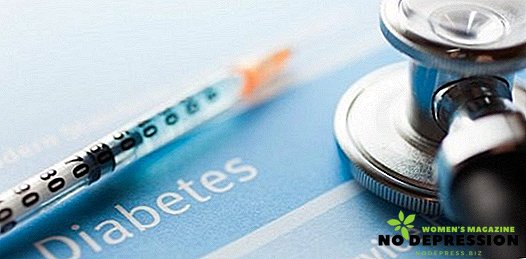Millions of people around the world suffer from diabetes. Without proper treatment, this disease can cause heart disease, lead to loss of vision. And in order to reduce the risk of developing this disease, you need to remember about measures for the prevention of diabetes.

Risk factors for diabetes
Before you study the methods of prevention, you should know in more detail about what risk factors lead to this disease.
Heredity
According to the observations of specialists, diabetes mellitus of the first type has hereditary "roots" in more than 10% of paternal patients and about 6% on the maternal one. In the presence of this pathology in both parents, the risks increase to 70%.
Obesity
 There is such a thing as body mass index, which is calculated by a simple formula: weight (in kg) divided by height (in square meters).
There is such a thing as body mass index, which is calculated by a simple formula: weight (in kg) divided by height (in square meters).
When this value ranges between 30-35, obesity is abdominal in nature (when the structure of the body resembles an apple), the risk of the appearance of pathology is very high.
Pancreas
Diseases, tumors of the pancreas, its damage can cause the development of diabetes.
Viruses
Diseases such as influenza, hepatitis and rubella can lead to this pathology, as they are a trigger. This means that a simple infection will not lead to the development of the disease in a healthy person, but if a person is at risk, even a simple cause can cause such a complication.
Wrong way of life
A person who leads a wrong lifestyle (smokes, drinks, does not play sports), more than others is at risk of developing diabetes.
Prevention brief
The well-known name of this disease is a silent killer, since about 20% of patients do not even suspect such a pathology. Therefore, it is important to know which measures will help reduce the risk of developing the disease:
- observe the daily regimen;
- do not be nervous, do not overwork;
- try not to smoke or drink alcohol;
- be physically active;
- eat well, try not to overeat;
- visit doctors and take tests at least once a year.
Preventive measures for men and women
For women
Women who are more than 17 kg after childbirth are at risk of developing diabetes mellitus; those who have given birth to a child weighing 4.5 kg. In this case, prevention should be addressed immediately after delivery.
The main preventive measures include:
- weight recovery;
- compulsory physical activities (simulators, sports);
- healthy lifestyle.
You should also think about the child. If the baby eats an artificial mixture, and not breast milk, it should be transferred to a lactose-free diet - the mixture, the main of which is not cow's milk, as it, when consumed in childhood, adversely affects the functionality of the pancreas.

Another important preventive measure is the creation of a healthy environment for the child, the prevention of various viral infections.
For men
Despite the fact that diabetes mellitus of the first and second type is considered a "female disease", men can also "face" this pathology. To reduce the likelihood of pathology, preventive measures should be started as early as possible. These include:
- weight loss;
- organization of proper nutrition;
- avoiding alcohol and smoking;
- control of arterial pressure and its normalization with the help of hypertensive drugs;
- Immediate treatment to the doctor when the first signs of the disease appear, and after 40 years it is necessary to take tests for determining the level of sugar once a year;
- Do not take medication without consulting a specialist;
- time to treat infectious diseases that can cause the development of diabetes.

All these activities will not only prevent the appearance of a "silent killer", but also normalize the work of the internal organs and regulate the heart rhythm.
What activities will help depending on the type of pathology
Type 1 diabetes is most often the result of a lack of insulin in the body. Patients with this diagnosis need regular insulin injections. This kind of often called youthful. According to statistics, they suffer from about 10-15% of diabetics. The second type of diabetes occurs as a result of insulin resistance - in which case the cells incorrectly determine the hormone insulin.
For type I
Prevent the occurrence of this type of diabetes is impossible, but there are several recommendations that will help slow the progression of the disease.
The main activities include:
- Balanced diet. Be sure to include in the diet vegetables and fruits, reduce the amount of canned foods. Also, carefully study the composition of products: try to include in the diet a minimum amount of artificial additives.
- Prevent the development of infectious and viral diseases, as even the common cold can have a serious complication in the form of diabetes.
For type II
At risk for this type of disease are people after 50 years, as well as those who have relatives suffering from diabetes. The main event is the annual sugar control. Due to this, it will be possible to diagnose pathology at an early stage.
Most often, this type of disease affects people who are prone to corpulence or already have obesity. In this case, it is very important to adjust the nutrition, following simple recommendations:
- despite obesity, you can not use "effective diets", promising to lose 10 kg per month;
- you need to eat in small portions, but at least 5 times a day;
- no need to overeat;
- should be included in the diet of fruits and vegetables and abandon the flour and sweet, canned.
You should also follow other recommendations:
- Try to play sports - every day, load yourself with moderate loads.
- Try to be in good shape: less nervous, avoid stressful situations, do not “kill” yourself at work, because nervous exhaustion is one of the main causes of diabetes.

Primary and secondary prevention
Primary preventive measures are to comply with a number of rules that will help prevent the development of pathology. Secondary will prevent complications in case of existing diabetes.
Primary
Here it is important to adhere to the rules already described above: do not overeat, play sports, avoid stressful situations, try not to get sick. However, there are factors that can not affect people: age-related changes, hereditary factors, pathology in development in childhood.
Secondary
If you are already sick with diabetes, you need to remember that this is not a sentence, because people have been living with this pathology for many years. To do this, follow the following recommendations:
- Maintain normal body weight and limit the amount of carbohydrates consumed.
- Physical activity based on age.
- The use of funds to reduce the level of sugar.
- Reception of multivitamins.
- Blood pressure control.
- Normalization of lipid metabolism.
- Switching to insulin preparations.
- Treatment of diseases of the internal organs, if any.
- Normalization of blood sugar levels.

Proper diet and a good menu for the day
To reduce the risk of diabetes, it is very important to consume "the right foods, which include:
- vegetables and fruits;
- chicken's meat;
- juices (the main thing is that there is no sugar in them);
- lean fish
Also very important:
- Consume foods in boiled or stewed form.
- To exclude from the diet smoked, salted and flour products.
- Instead of sugar, use sweeteners.
There are lots of diets that can be used for diabetes. The main thing is that they are not dangerous for the body: nutritious, nourishing, diverse. Sample menu for the day may be as follows:
 For breakfast you can make porridge with milk, scrambled eggs from two eggs. As an easy and useful dessert - 200 g of cottage cheese with a low percentage of fat and a handful of any berries.
For breakfast you can make porridge with milk, scrambled eggs from two eggs. As an easy and useful dessert - 200 g of cottage cheese with a low percentage of fat and a handful of any berries.- At lunch you can eat a few baked apples, drink 200 ml of yogurt or rosehip broth.
- For lunch - 150 ml of borscht or vegetable soup. On the second - 15 g of boiled breast, 120 g of baked vegetables or salad from fresh tomatoes, cucumbers and cabbage.
- During an afternoon snack, you can pamper yourself with a tender casserole of cottage cheese. But you can replace the boiled egg with a glass of kefir.
- You can pamper yourself with different types of dinner: 250 g of baked fish; cutlet with vegetables; boiled shrimps with legumes, such as asparagus beans.
By sticking to this menu every day, you gradually normalize sugar levels, reduce weight, speed up metabolism. Moreover, you need to prepare any dishes with a minimum amount of sugar, fat and salt, and it is better to exclude them from the diet altogether.
How not to get diabetes?
A person leading an active and healthy lifestyle is less susceptible to this pathology. And there are many options where you can "put" your energy into good:
- Walking. Regular walks to reduce the risk of diabetes. 3 kilometers per day reduced the risk by 18-20%.
- Swimming. It is considered a universal way for many diseases. In this case, the load affects all muscle groups, has a positive effect on the respiratory system and the heart.
- Bicycle riding. Such trips not only generally strengthen the body, but also reduce the level of glucose in the blood.
Thus, in order not to get sick with diabetes, you need to try to keep a healthy image, not forgetting about the above activities.

The role of a nurse in this pathology
After the treatment is prescribed, the nurse spends a lot of time with patients with this disease, therefore, her role is very significant. It is the mid-level staff that should monitor the patient's fulfillment of all the doctor's prescriptions, have qualities such as patience and kindness, and have the required knowledge to monitor the patient's condition.
It is the nurse who collects all the information about the patient, conducts examinations, contacts the doctor, prescribes preventive measures depending on the type of diabetes, the patient's condition.
Her professional responsibilities include the following activities:
- performing doctor's appointments;
- interaction with other narrow specialists for the appointment of surveys;
- contact with the patient and his relatives;
- monitoring the implementation of the recommendations of the attending physician;
In addition, if insulin injections were prescribed, they are first done by a nurse, who is also responsible for teaching the patient how to perform such procedures.
When diabetes mellitus complications are frequent: coma, manifestations of the cardiovascular system, netinopathy. When they are detected, the nurse must call the doctor, prepare the medications required for the administration, and ensure that the patient is in a stable position. The quality of the performance of official duties largely depends on the health and life of the patient.


 For breakfast you can make porridge with milk, scrambled eggs from two eggs. As an easy and useful dessert - 200 g of cottage cheese with a low percentage of fat and a handful of any berries.
For breakfast you can make porridge with milk, scrambled eggs from two eggs. As an easy and useful dessert - 200 g of cottage cheese with a low percentage of fat and a handful of any berries.









